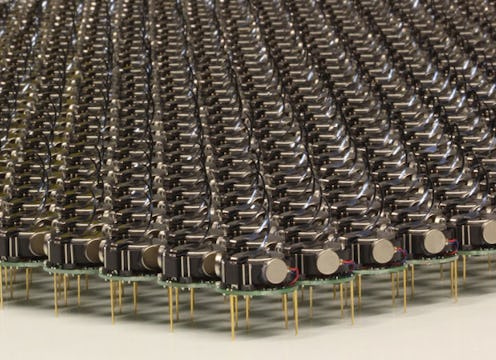News
Uh, Harvard's Created An Army Of Robots Now

Inspired by the collective activity of the natural world (and apparently undeterred by every science fiction film, ever), Harvard researchers have created the world's largest army of robots, called Kilobots — 1,024 of them, in fact. These Kilobots are your basic futuristic nightmare: they work autonomously. They mimic the behavior of insects. They communicate with each other. They swarm and create shapes, without any human input. Yes, they're still at the primitive stage but let's not beat around the bush here: these are clearly the beings of the future and we should treat them with respect lest we be turned into future robot-slaves.
How They Work
Picture, in your mind, something akin to an ant colony, or a bee hive. The penny-sized Kilobots have three major components: vibration motors (so that they can turn or go straight); infrared sensors and transmitters (so that they can communicate with each other), and a micro-controller. And what they're programmed to do is relatively simple — they can tell their position, more or less, and they can tell where the edge of the group is. They can also track their own distance, and how far away they are from their fellow bots. This allows them to work as a group without an outside, guiding central intelligence.
What They Do
Here's where it gets fascinating/futuristic/terrifying. These 1,000 or so tiny bots are given a picture of a particular shape and then — they'll create that shape out of themselves. So, for example, if the picture is of a star, all 1,000 of them will self-assemble to make a 2D star. Or a "K." Or a figure. It can take up to 12 hours for all the bots to complete the complex shape, but still, it's impressive — especially since the bots can solve issues like traffic jams or the random bot that wanders off-course.
"Each robot looks at its current state — so, what have I done in the past — and also looks at what its neighbours are doing, based on communication. And it makes its own decisions," Dr Rubenstein, who lead the research, told the BBC."Running this identical program, all the robots are capable of taking turns to join the shape."
What They Could Do In the Future
Of course, making pretty shapes is hardly the point of a robot army. What these self-organizing bots could do eventually is much more exciting — they could venture under the sea or across the universe. According to Roderich Gross, a robotics lecturer at the UK's University of Sheffield, the bots could even make their way into human beings: "Swarms of micro-scale robots could travel inside the vascular network for non-invasive diagnosis and treatment," Gross told The New Scientist. "The next challenge is to generate shapes in 3D and to deploy such robot swarms in real world applications."Before you start hyperventilating, bear in mind that the bot army is still far from perfect. Added Rubenstein:
These robots are much simpler than many conventional robots, and as a result, their abilities are more variable and less reliable. For example, the Kilobots have trouble moving in a straight line, and the accuracy of distance sensing can vary from robot to robot.
Oh, thank God.